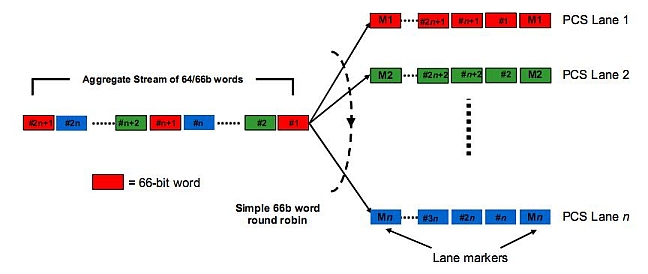40G / 100G Ethernet standardized

In June of this year, the IEEE 802.3ba standard was ratified, describing two new speeds simultaneously: 40 and 100 Gbit / s. This news did not pass by Habr, however slipped somehow easily, imperceptibly and without details. Well this is not a new android firmware, in fact :)
I will try to still add a little bit of facts.
Development has been carried out, practically, since 2006. Some have already launched their pre-standard products (for example, Cisco with trial CRS-3 and Juniper, which presented the 100G interface for the T1600 router in 2009), but this, according to IEEE and equipment manufacturers, will not lead to incompatibility, . vendors in their development were based on the standard draft existing at that time.
The need to bring new high-speed Ethernet solutions to the market has been long overdue, since Not only the cores of the networks of major service providers have already outgrown 10G, but also the edge equipment sometimes requires completely different capacities, and the aggregation of 10G channels turns out to be less efficient both technologically and economically. If long reach optical devices for 40G / 100G are still very expensive, then the prices for short reach should be quite reasonable now and even lower than the initial cost of 10G ports (IEEE and vendors promise us).
Let's take a closer look at the 802.3ba architecture.

The standard is based on IEEE 802.3: neither the frame format, nor its dimensions, nor the full duplex principle of operation change.
LLC (Logical Link Control) and MAC (Media Access Control) levels corresponding to Layer 2 OSI models remain unchanged. The MAC connects to the media (media) through the PHY layer (corresponds to Layer 1 OSI). In turn, the PHY level includes the PCS (Physical Coding Sublayer), PMA (Physical Medium Attachment), PMD (Physical Media Dependent), and, optionally, FEC (Forward Error Correction) sublevels.
RS (Reconciliation Sublayer) is a matching sublayer that transmits a sequence of bits from the MAC layer to the MII (Media Independent Interface). There are two MII interfaces described in the standard: XLGMII for 40 Gbit / s (Roman XL = 40) and CGMII for 100 Gbit / s (Roman C = 100). They are based on the former XGMII (10 Gbit / s) and are logical, in-circuit interfaces providing 64-bit (8 bands of 8 bits) data transmission / reception channels to the PHY (physical layer). MII also provides a clock frequency of 625 MHz for 40 Gb / s and 1.5625 GHz for 100 Gb / s for both reception and transmission.
The PCS is responsible for encoding and scrambling the bitstream during transmission and the inverse of reception. The same coding scheme is used as in 10G - 64B / 66B (66 bits of a linear code on 64 bits of data). To implement high speeds, a special MLD technique (Multilane Distribution) was developed, the essence of which is round-robin interlacing of 66-bit data blocks across several bands (I don’t know how to more adequately translate lane). The advantage of this technique is its full realizability on CMOS, which will ultimately remove the load on processing the bit stream from the electronics built into the optical interface, and this will simplify its functionality (read, increase reliability) and significantly reduce the cost.

Periodic insertion of markers into the bit stream allows on the receiving side to compensate for possible shifts of bit groups and fully restore the initial aggregate signal.
PMA converts code groups to serial (serialize) and reverse processes (deserialize). The specific implementation of PMA depends on the PMD sublayer, i.e., in essence, on the type of medium and transmitter.
Finally, PMD is responsible for transmitting a sequence of bits to the physical medium via MDI (Media Dependent Interface).
Several specifications of the physical layer have been developed, as usual, differing by the transmission range and the type of transmission medium:

Optics assumes the use of wave compaction - on 40G CDWM (Coarse Wave Division Multiplexing), on 100G - DWDM (Dense Wave Division Multiplexing) technology.
And copper is harsh cables like this .
The form factor for the standard is supposed to be CFP (C form-factor pluggable) in the same way as for 10G the form factor was XENPAK. To do this, as they have taken, concluded Multisource Agreement, to agree on all the necessary parameters between different manufacturers.
')
Here, in brief and superficially, is the description of the new 40G / 100G Ethernet standard, which will determine the development trends of network equipment for the next few years. Moreover, the chief executive of the 802.3ba development team, John D'Ambrosia, claims that 100G is just a bridge to a terabit Ethernet, and suggests that a standard for it should be developed by 2015.
In addition, some of the Internet giants mentioned that even now, ideally, they would be happy about exactly 1T-Ethernet.
Source: https://habr.com/ru/post/102432/
All Articles